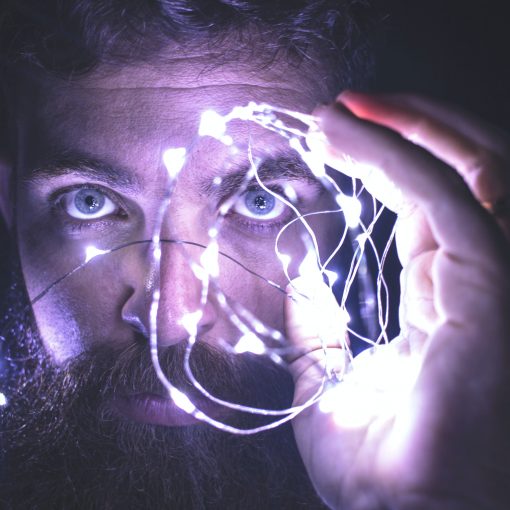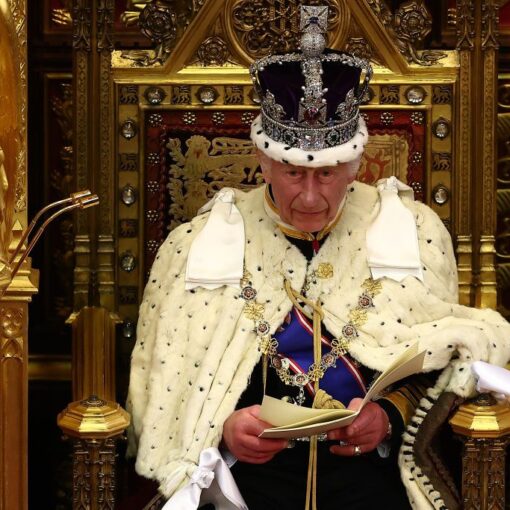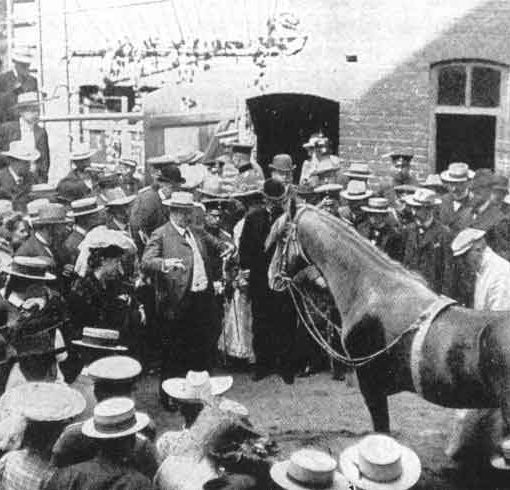The stories we tell ourselves influence everything. Period. We make sense of the world in narrative.
Whether that is in the way that we learn the journey from A to B. Remembering the last place that we left our car keys or recalling a memory of an interaction with another person. Each in their own way is part of our conscious or subconscious narratives.
Everyday these stories that we tell ourselves shape our beliefs. In so doing they are manifest in our behaviour and serve to frame our experience. They feed into how we feel about things and so shape our emotional state.
Real story-telling reaches back to oral cultures, it is an embodied somatic expression. These tales do not just engage us with their tales of daring do, but they carry deeper messages. This is where the story deepens into the realm of mythology.
The lies that tell the truth
Professional story-teller Michael Meade calls mythology “the lies that tell the truth” and continues that they tell “the reality behind reality”. Within their narrative are woven the knowledge and wisdom of communities and cultures. In oral cultures such stories were the only way to retain this knowledge.
Academic and author Joseph Campbell defined four levels of meaning within mythologies, the spiritual, the cosmological, the societal and the personal (my words). The tales are replete with information that helps individual make sense of themselves, understand the framework of their culture, and place those within their physical and spiritual universes.
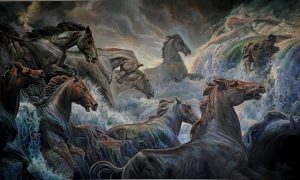 Campbell asserts these are universal elements of lie beneath traditional tales around the world. These common dualities repeat through time from the Epic of Gilgamish, to the Old Testament, to King Arthur and to the Norse sagas.
Campbell asserts these are universal elements of lie beneath traditional tales around the world. These common dualities repeat through time from the Epic of Gilgamish, to the Old Testament, to King Arthur and to the Norse sagas.
Facts are all very good, but they too easily forgotten. Stories linger and bewitch. When we weave fact into the threads of adventure we engage. When we engage, we create memories. Think how much easier it is the remember the procession of the stars through the night sky if we think of them as the journeys of our heroes.
Two different types of knowing
To the ancient Greeks there was two different times of knowing – they called them Mythos and Logos. Logos were the facts – it told us the sky was blue, wood burned in fire, the sun rose each morning in the east. You know the sort of thing. Highly logical, very Mr Spock for the aging Trekkies.
In Mythos there was something more personal – an experienced knowing. A knowing that is attributed to the heart and soul. Not the mind. Story-telling weaves the mythology, it captures the knowledge by capturing the listener. Creating the memory of vicarious adventure and in so doing subliminally capturing the knowledge.
Whether we are telling the tales of passing of seasons, volcanic eruptions, or submersion of lost civilization in a global deluge. Whatever, how much easier to remember tales of sunken Atlantis or Noah saving the diversity of life from a great flood.
These are experiential knowings – whether we are telling or listening.
A little neuroscience
In a society that needs proof – facts or logos if you like – the fMRI is shining lights into our thought process.
One interesting element of the story telling approach is mirroring of experience between teller and listener. My brain mirrors yours as you recite your tale. Quite literally, your experience becomes mine.
Further my engagement with your story stimulates neurotransmitter activity which strengthens my memory creation. Tell me a good story, engage me, and I am much more likely to remember. And as every avid book reader knows, how often do we feel at one with a lead character in our favourite books.
Narrative not only helps us makes sense, but it strengthens our awareness of, and engagement, with our world.
Making sense
And so our stories come together to create our experience. Our everyday mythos shapes our views and feelings of the world.
Through time we have sought to comprehend our journeys and our mythologies – Joseph Campbell codified this in his 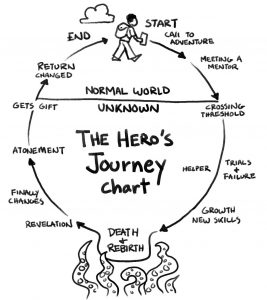 seminar book “The Hero with a thousand faces.” He called it the Hero’s Journey. A cycle repeated through myth after myth, and repeated today in common sagas such as Harry Potter or Star Wars. It is not by luck alone that we are drawn to these tales. We see our own battles played out in their adventures. Seeing them endure and succeed gives us inspiration and hope.
seminar book “The Hero with a thousand faces.” He called it the Hero’s Journey. A cycle repeated through myth after myth, and repeated today in common sagas such as Harry Potter or Star Wars. It is not by luck alone that we are drawn to these tales. We see our own battles played out in their adventures. Seeing them endure and succeed gives us inspiration and hope.
One of the oldest models is the major Arcana of the Tarot deck. With its roots in Ancient Egypt, it maps the journey of “The Fool” card 00 through the archetypal challenges that we face on our journeys. For thousands of years this model has provided insights which give people hope and direction. (I have developed a horse guided set with the team at Athena Herd – click here to see more – to help our clients explore their issues).
Being heard
It is in the telling of a story that it comes to life.
One of the incredible feats of mental processing is the synesthetic hallucination of reading. It takes random printed characters from a page and then creates an absorbing and immersing images within our heads. And then emotionally engages our consciousness. When you break it down this way it is almost magic.
And in many ways that's what our stories are, a means of entrancing others within our narratives. But we are not about the books here. We each have a story. Not a fiction, but a very real and personal narrative which carries the stories of being ourselves.
Our stories need to be heard, just as our being seeks to be acknowledged.
In this way the greatest gift we can offer another being is to hear there story. Not to opine, not to enrich, simply to hear and be curious. Each one of us knows the pain of not being heard. Conversely, we all know the catharsis of being heard.
As a social animal we are bound by empathic understanding. Sharing our stories is a key thread that embodies the building of those bonds.
Shaping experience
Like all good story cycles, let us return to where we began. Everyday these stories that we tell ourselves shape our beliefs. In so doing they are manifest in our behaviour and serve to frame our experience.
Quite simply, our stories both form and are informed by our experiential knowing. Connecting with Mythos connects us with the real experience. The reality within rather than the interpreted.
To close, if we acknowledge this power of narrative then we can acknowledge that we can change it. We can choose what narrative we engage. And so can choose how we might shape our experience. The stories that we tell ourselves both frame and give shape to our experiences.
Go ahead readers…. make your day.
(I do not own all the images in this blog).

